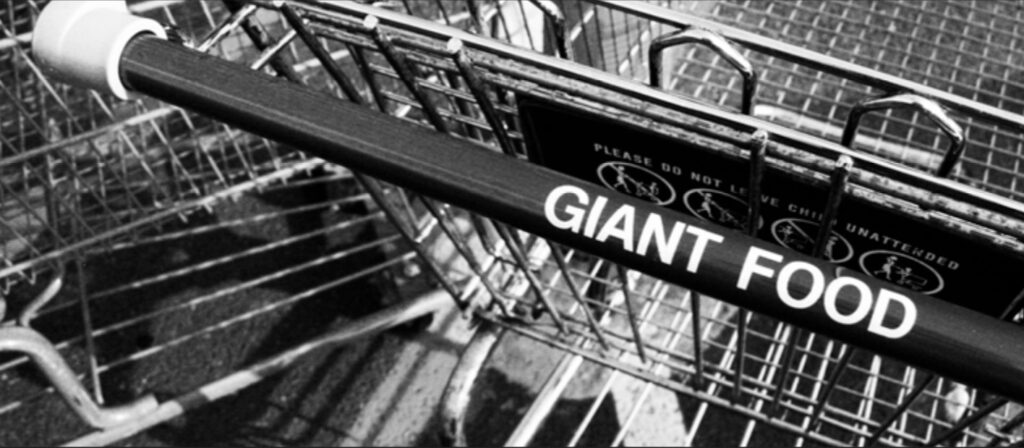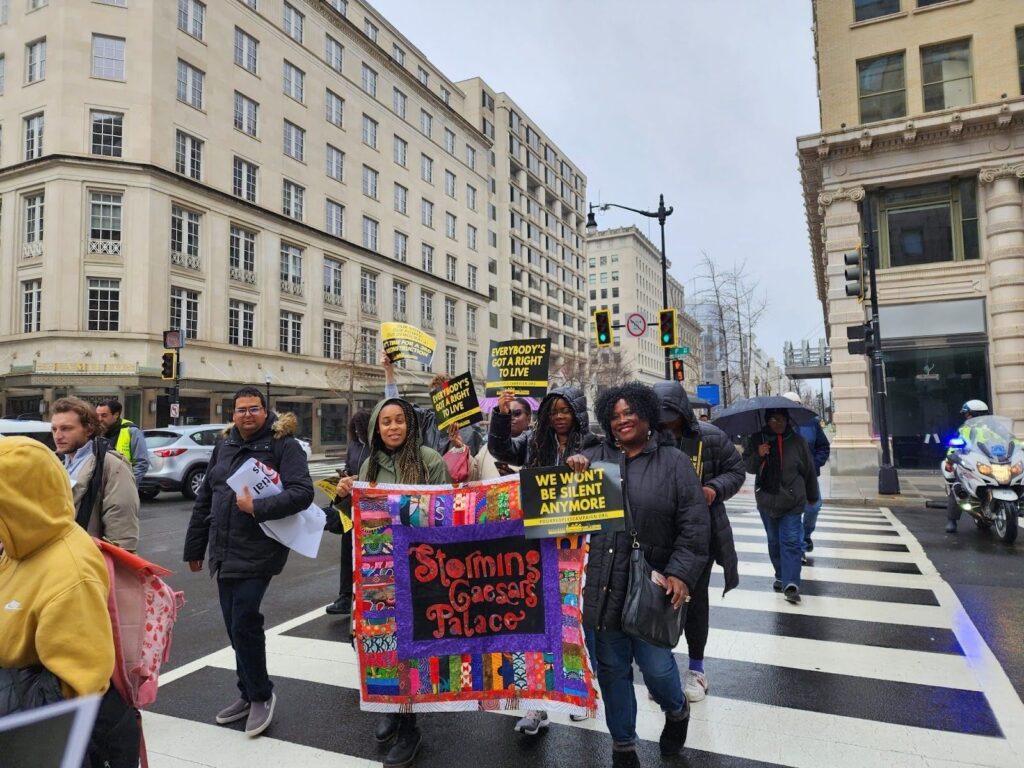Giant Supermarket changes food landscape in Southeast
Just a few blocks from the Congress Heights Metro in Southeast, D.C., a large parking lot opens before a Giant Food supermarket. Two men emerge and one jokes to the other that as hot as it is, he just may shop all day. Inside, customers look at boxes of cereal and granola, milk and cheese. A line of shoppers has formed at every cash register, but in the air-conditioned environment, no one seems to mind a brief wait.
Three years ago, this area would have been described as a “food desert,” or an area where healthy and affordable food is difficult to access or inaccessible. The phrase may conjure thoughts of problems of developing nations, but a food desert is an American predicament, affecting people locally and nationwide.
A food desert is not altogether devoid of food. Rather, such areas tend to be dotted by fast-food establishments, liquor stores and regional or ethnic restaurants that may serve heavily salted, sugared and fatty foods. In a food desert, there is often enough total food in caloric terms, yet, due to a lack of affordable fruits, vegetables and healthy grains, there is not enough food to accommodate the community nutritionally.
The ironic result of a food desert is that these communities reflect both high levels of hunger and abnormally high rates of obesity and heart disease. According to D.C. Hunger Solutions, a nonprofit agency that specializes in nutrition and health issues in the District, Wards 7 and 8 have the highest rates of poverty and obesity and house only seven of the District’s 43 full-service grocery stores.

A lack of healthy food is a problem that affects many people. According to a U.S. Department of Agriculture report, 12 percent of Washington, D.C. households were “food insecure”—regularly running out of food or simply not knowing where the next meal will come from—from 2006 to 2008. Another report from the Food Research and Action Center said that 40.6 percent of D.C. households with children experienced food hardship in 2009.
U.S. Census Bureau worker Lynda Laughlin wrote in an article for the online magazine Greater Washington that “Wards 2 and 3 have 16 grocery stores. That’s one store for every 8,911 residents. Ward 4 is the most populated ward (about 75,000 people) but only has one grocery store. There are only three grocery stores east of the river for residents of Wards 7 and 8. That’s one store for every 47,151 residents. Communities with large populations in poverty or large minority populations have poor access to grocery stores.”
“There is a clear grocery gap in Washington, D.C., and low-income residents bear the brunt of this gap,” said Alexandra Ashbrook, executive director of D.C. Hunger Solutions, in the report When Healthy Food Is Out of Reach. “For families that are struggling with low wages, not having access to grocers impacts both their wallets and their health. Families whose budgets are already stretched to the limits don’t have the extra money to pay for additional transportation costs or higher prices.”
Healthy foods with appropriate nutrient contents, particularly in these areas, can be expensive. So consumers, often working with tight budgets, tend to select comparatively cheap and filling, though unhealthy, food choices such as fast food, potato chips, white breads and heavily sugared juices. Frozen produce is typically purchased. Consequently, many residents of food deserts experience hunger and can show signs of malnutrition, such as fatigue, difficulty concentrating and lethargy. Overall, their diets can lead to obesity and related health problems.
While many Washingtonians continue to struggle with food access, residents of Congress Heights have seen large improvements in the last two-and-a-half years. “Before, there was only one grocery store. I don’t have to go all the way to Maryland anymore to get groceries,” said one customer of the Congress Heights Giant.
Jamie Miller of Giant’s public affairs department said the company “realized that [southeast D.C.] was an underserved community, and from a business standpoint, [Giant] realized that there was an opportunity.” Prior to the store’s opening in December 2007, area residents had limited options to purchase groceries.

The Giant at Congress Heights is helping to change this. “[The Giant] helps a whole lot,” said Miss Pearson, a local school crossing guard. “[We] used to have to go all the way to the top of the hill. And the little convenience stores charge entirely too much. The [Giant] is very convenient.”
“When it comes to fruits and veggies, it’s great. The salad bar and everything is just great,” said resident Lula Evans. Before the Giant store opened, few stores in the area would have been described in this way. Before the supermarket opened, locals shopped at a Safeway grocery store a mile-anda-half up Alabama Avenue. But some, particularly those living on the western side of Congress Heights, found the distance to the Safeway difficult to traverse.
The Giant’s proximity and perks have made shopping experiences not only easier, but generally more positive for residents. “I haven’t been to the Safeway since [the Giant] got here,” said customer Gloria Johnson. “Most of my friends are the same way. It’s easy. I can walk [there]. And they’ve got courtesy rides that’ll take you if you don’t have a car.”
Other shoppers agree. “It’s very convenient. I’m very pleased to have it in the neighborhood,” said M.K. Banks, Capital Heights resident and native Washingtonian.
“I think it’s been a real blessing to have a Giant this close,” said Cheryl Chadwick, resident and member of D.C. Metropolitan Foster and Adoptive Parent Association (DCMFAPA), a nonprofit organization that engages in support, training and education for foster parenthood in the D.C. area. “It used to be that you had to take transit if you lived on this end of Alabama Avenue.” Chadwick emphasized the importance of the Giant for her own organization and the community as a whole. “They’re good about community outreach, too,” she noted.
She said that it is not uncommon for groups like DCMFAPA to be found tabling outside the Giant, as the store is supportive of a number of local improvement groups and nonprofit organizations.
The support offered by a supermarket is not limited to its support for community causes. In 2008, the Bureau of Labor Statistics ranked grocery stores among America’s largest industries.
Grocery stores hire large numbers of youth; 15.9 percent of their employees are ages 16-19, and another 13.5 percent are ages 20-24. Part- or full-time jobs as stockers, baggers and cashiers give many youths their first real job experience.
The Giant at 1535 Alabama Ave. hired about 200 employees when it opened. Of these employees, around 90 percent were from Ward 8. That translates to around 180 jobs provided directly to the community.
The workers are bustling and energetic. One employee wittily encourages two others. A woman in an apron and a Giant baseball cap busily replaces cookies in the bakery area. A man pushing a large dolly stops his work to give a customer directions to the restroom; seeing the customer again, he checks to make sure the customer found it. Teenage boys restock shelves with neat rows of cereal and spaghetti sauce.
A Better Future
There is hope that other areas of Wards 7 and 8 will soon see similar improvements in food access. Yes! Organic Market is opening its first store east of the Anacostia River at 2321 Pennsylvania Ave., S.E. in August, providing the area with its largest and most extensive organic market to date.
Michelle Obama has taken note of the challenging issue of food deserts locally and nationally and has made their eradication a key component of “Let’s Move,” her initiative for healthy children. In February, Obama appeared on FOX news and said, “We have to eliminate food deserts. One of the goals of Let’s Move is to eliminate food deserts in seven years.”
Obama emphasized that 23.5 million Americans currently live in areas with limited access to healthy food choices. Her proposed initiative includes $400 million in funding to address food deserts and bring healthier foods to America, especially its children.








